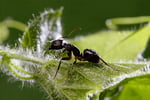As we come into the 2017 lawn care season, snow mold is going to be an issue for many of the markets that Senske serves. Given the amount of winter precipitation, we anticipate seeing greater than normal amounts of gray and pink snow mold. We are already seeing signs of snow mold at our corporate headquarters in Kennewick, WA.
So what exactly are snow molds?
Gray and pink snow molds are fungal diseases that affect cool season grasses during and after snow events. The fungi remain dormant in the soil or plant debris during the summer and become active in the winter beneath snow mats on unfrozen turf. The fungi grow best in matted turf when soil temperatures are slightly below freezing and continue to grow as long as the surrounding grass/soil remains cool and moist. Snow molds cause circular gray, pink, or straw colored patches in turf. As temperatures rise above 45⁰F, gray snow mold fungi stop growing and dry out. However, pink snow mold can last into the spring and will continue growing until temperatures are consistently above 60⁰F.
Generally, snow molds do not cause significant damage, but lawns affected by the mold will take longer to green up. So, what can we do to help your turf bounce back from snow mold?
Things to Do
- Spread snow piles, especially in shaded areas.
- If there are signs of snow mold, rake the lawn and remove affected turf. Raking opens airways and promotes the movement of air through the turf.
- Snow mold grows well in turf with a dense thatch layer. Early season aerations enhance air movement and decrease the opportunity for fungal success. If the turf is heavily damaged, then we recommend an aeration followed by an overseed treatment.
Gray Snow Mold

Pink Snow Mold

Pink Snow Mold











